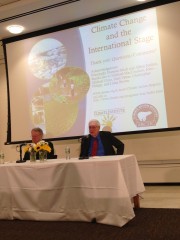 Thursday evenings at Columbia University are dedicated to climate change. As part of the Summer 2013 Hertog Global Strategy Lecture Series, an expert in the field of climate and Earth studies is invited to deliver a lecture on a topic of his or her choice. Each week, the lecture takes place in the International Affairs Building at Columbia University’s main Morningside campus and is open and free to the public.
Thursday evenings at Columbia University are dedicated to climate change. As part of the Summer 2013 Hertog Global Strategy Lecture Series, an expert in the field of climate and Earth studies is invited to deliver a lecture on a topic of his or her choice. Each week, the lecture takes place in the International Affairs Building at Columbia University’s main Morningside campus and is open and free to the public.
On Thursday, June 13, John Topping, President and CEO of the Climate Institute, gave a talk called “Slowing Arctic Melting: Beginnings of a Regional Strategy to Mitigate Climate Change.” His address drew largely on the goals and actions of the Arctic Climate Action Registry (ACAR), a registry aimed at supporting boosting up-and-coming climate change projects. The initiative works toward its goal of reducing the Arctic Regional Mean Temperature one degree by 2015.
Mr. Topping began with an alarming figure: in 2012, 3,261 cubic kilometers of ice were measured on the Arctic Sea, a shocking reduction from the 16,855 cubic kilometer volume recorded in 1979. A significant portion of that loss, he explained, comes from a category of fuel sources known as Short Lived Climate Forcers. These SLCFs (common examples of which include tropospheric ozone, methane, biomass burning, and black carbon) contribute heavily to climate-warming emissions, black carbon especially.
Topping attributes much of the black carbon in the atmosphere to Arctic air overflights. Beginning in 1998 with Russian planes, today over 40,000 flights are flown over the Arctic each year, he says. Mark Jacobson of Stanford University claims that rerouting these flights may reduce emissions by up to 83 percent.
Topping identifies shipping, oil, and gas development projects, and mining as chronic causes of emissions. The main challenge to these causes, he says, is the failure of “Kyoto Protocol-based trading systems to incentivize action.” According to Topping, the Climate and Clean Air Coalition is responsible for the only action currently underway.
In terms of what action should be underway, Topping presents three geoengineering strategies. First, small ships should be dispatched periodically to scatter sea salt, he says. This tactic is based on the assumption that salt forms clouds that raise albedo and reflect heat. The second strategy deals with seasonality of Arctic ice breaking. He proposes moving the season for breaking from spring to fall, citing the difference in temperature ranges during the respective seasons. Finally, supplements such as nitrate and sulfate should be used to boost the productivity of methanotrophs. These methanotrophs then absorb Arctic methane, a SLCF.
John Topping remains optimistic about the Earth’s climate future, a feeling that is reinforced by American emission levels dropping to 1994 levels and the employment of natural gas instead of coal to power the utility sector. In addition, he says Mexico and China are moving aggressively to mitigate the effects that have already taken a toll on our planet.
In closing, Topping responded to an audience question about the purpose of the Climate Institute and declared that the Institute’s main goal is to “slow climate change until it is within the capacity of natural ecosystems and humans to adapt.” That is a feat John Topping believes can be achieved by the collective action and commitment that is already underway.